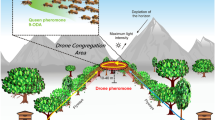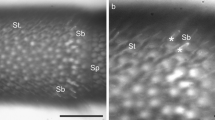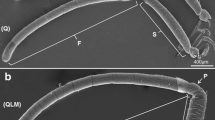Summary
In field experiments drones of Apis mellifica were attracted by queens of Apis mellifica and of A. cerana. On days of low sexual appetite the drones showed a significant preference for their own queen.
In both species we recorded spikes and slow potentials from the poreplates of the drones antennae. The same type of olfactory sense cells responds to 9-oxotrans-2-decenoic acid (queen substance) and to the secretion of the mandibular gland of Apis cerana. The quantitative relationship of the effects of the queen substance probes and of the cerana-mandibular glands were the same in both species.
Olfactory cells of the same type were found on the queens' and workers' antennae of both species. Another cell type common to all castes of both species responds to the scent of the Nasanov gland of A. mellifica.
Zusammenfassung
In Feldversuchen an Drohnensammelplätzen wurden Königinnen von Apis mellifica und A. cerana von mellifica-Drohnen angeflogen. Die arteigene Königin wurde bei gleichzeitiger Darbietung der artfremden Königin in manchen Fällen (an Tagen mit geringer sexueller Appetenz der Drohnen) gesichert bevorzugt.
Elektrophysiologisch konnten von den Porenplatten der Drohnenantennen beider Arten langsame Potentiale bei Reizung mit 9-Oxo-trans-2-decensäure (Queen substance) abgeleitet werden. Auf dieselben Riechzellen wirkt auch das Mandibeldrüsensekret von A. cerana. Bei beiden Arten standen die Wirkungen von Queen substance-Proben und von Cerana-Mandibeldrüsen zueinander im gleichen Verhältnis.
Riechzellen des gleichen Typs finden sich auch auf den Antennen von Arbeiterinnen und Königinnen beider Arten. Ein anderer Riechzelltyp bei allen Kasten beider Arten reagiert auf den Sterzelduft von A. mellifica.
Similar content being viewed by others
Literatur
Butler, C. G.: Die Wirkung von Königinnen-Extrakten verschiedener sozialer Insekten auf die Aufzucht von Königinnen und die Entwicklung der Ovarien von Arbeiterinnen der Honigbiene. Z. Bienenforsch. 8, 143–147 (1966).
Butler, C. G., D. H. Calam, and R. K. Callow: Attraction of Apis mellifera drones by the odours of the queen of two other species of honeybees. Nature (Lond.) 213, 423–424 (1967).
—, and E. M. Fairey: Pheromones of the honey bee: Biological studies of the mandibular gland secretion of the queen. J. apic. Res. 3, 65–76 (1964).
Gary, N. E.: Chemical mating attractants in the queen honey bee. Science 136, 773–774 (1962).
Kaissling, K. E., u. M. Renner: Antennale Rezeptoren für Queen substance und Sterzelduft bei der Honigbiene. Z. vergl. Physiol. 59, 357–361 (1968).
Oschmann, H.: Eine bienenkundliche Reise in die Volksrepublik China. Arch. Geflügelzucht Kleintierk. 10, 235–255 (1961).
Pain, J., et F. Ruttner: Les extraits de glandes mandibulaires des reines d'Abeilles attirent les mâles, lors du vol nuptial. C. R. Acad. Sci. (Paris) 256, 512–515 (1963).
Ruttner, F., u. Ruttner, H.: Untersuchungen über die Flugaktivität und das Paarungsverhalten der Drohnen. 3. Flugweite und Flugrichtung der Drohnen. Z. Bienenforsch. 8, 332–354 (1966).
Simpson, J.: Male genitalia of Apis species. Nature (Lond.) 185, 56 (1960).
Author information
Authors and Affiliations
Additional information
Für die freundliche Überlassung von Proben synthetischer 9-Oxo-trans-2-decensäure danken wir Herrn R. K. Callow (Rothamsted) und H. Rembold (München).
Rights and permissions
About this article
Cite this article
Ruttner, F., Kaissling, K.E. Über die interspezifische Wirkung des Sexuallockstoffes von Apis mellifica und Apis cerana . Zeitschrift für vergleichende Physiologie 59, 362–370 (1968). https://doi.org/10.1007/BF00365968
Received:
Issue Date:
DOI: https://doi.org/10.1007/BF00365968




